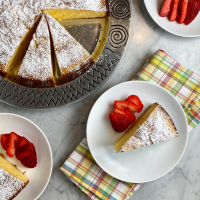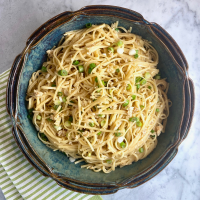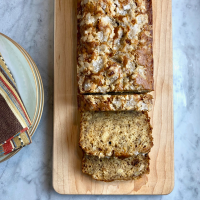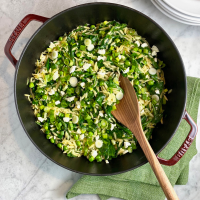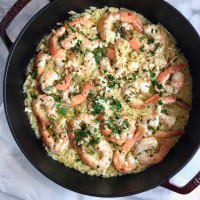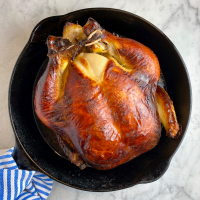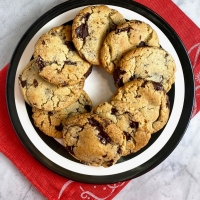
Every Mardi Gras, I have made the same King Cake for as long as I can remember. It was a big deal for me to try a new version!
I was drawn to this recipe because I liked the idea of adding texture with the caramel crunch layer- and my family loves cream cheese frosting. It was delicious. The frosting was definitely a winner, but next time I would omit the caramel crunch- the cake didn’t need the extra sweetness. I still included it as an option in the recipe below.
The recipe was adapted from Food and Wine, adapted from The Good Book of Southern Baking by Kelly Fields with Kate Heddings. I weighed the ingredients and modified the method. I used a cake pan but may opt for a cake ring or springform pan next time so that it would be easier to transfer the cake to a rack to decorate.
I decorated the cake with the traditional Mardi Gras sanding sugars. The recipe notes that the green, purple, and gold sugars represent faith, justice, and power, respectively, a nod to the “three kings.” Instead of placing a plastic baby inside, our family tradition is to place chocolate inside (a few dark chocolate chips this year). The person who receives the special slice with chocolate will have a lot of luck this year. 🙂
Yield: One 10-inch cake
For the Cake:
- 300 g (2 1/2 cups) bread flour
- 80 g (2/3 cup) all-purpose flour
- 2 tsp instant yeast
- 2 eggs, at room temperature
- 1 cup whole milk
- 28 g (2 T) lard (28g) (you can use vegetable shortening or butter, but it won’t be as delicious)
- 67 g (1/3 cup; 5 T) granulated sugar
- 1 tsp kosher salt (Morton’s)
- 5 T unsalted butter, cut into 5 pieces, at room temperature
For the Cinnamon Filling:
- 67 g (1/3 cup) granulated sugar
- 52 g (1/4 cup) firmly packed light brown sugar
- 1 T ground cinnamon
- 4 T unsalted butter, at room temperature
- 1/4 to 1/2 tsp Kosher salt
- 1 tsp pure vanilla extract
For the Caramel Crunch:
- 100 g (1/2 cup) granulated sugar
- 1/2 tsp light corn syrup
- 1/4 cup water
For the Cream Cheese Frosting & To Decorate:
- 4 oz cream cheese, at room temperature
- 511 g (4 1/2 cups) Confectioners’ sugar, sifted
- 4 to 8 T whole milk or heavy cream (I used 6 T cream plus 1 T milk)
- 1/4 tsp vanilla bean paste or vanilla extract
- purple, green, and yellow sanding sugars, optional
To Make the Cake:
- In a large bowl, whisk together bread flour, all-purpose flour, and yeast.
- In the bowl of a stand mixer or in a large bowl using a handheld mixer, whisk eggs until smooth.
- Switch to dough hook or a large wooden spoon, and add milk, lard, and flour mixture. Mix on low speed until a dough starts to form, 3 to 4 minutes.
- Stop mixer and scrape down sides of bowl with a spatula. With mixer on low speed, add sugar and salt, then increase speed to medium, and mix for 3 minutes.
- Decrease speed to low and add butter, one tablespoon at a time, until fully incorporated.
- Increase speed to medium-high and beat dough for 5 to 7 minutes, until butter is fully incorporated and the dough is silky and shiny.
- Coat a large baking sheet with cooking spray.
- Transfer dough to baking sheet and press it with heel of your hand to about 3/4-inch thick and as close to a 6- by 10-inch rectangle as possible (it’s fine if it’s a little wider or longer).
- Cover baking sheet in plastic wrap and refrigerate overnight (about 12 hours). Dough can also be frozen, but will need to thaw overnight in the refrigerator before using.
- Make the cinnamon filling, directions below; set aside.
- Lightly coat a 10-inch-round cake ring or springform pan or cake pan with 2-inch-high sides (I used a fluted 10.5-inch pan with 2-inch sides) with cooking spray. (A cake ring or springform pan may be a better choice because it was difficult to maintain the shape when transferring out of the baking pan and onto the cooling rack.)
- Cut the cold dough into two 3-by-10-inch strips.
- On a pastry mat sprinkled with flour, use a lightly floured rolling pin to roll each piece evenly to approximately 6 by 12 inches, maintaining a rectangular shape.
- Sprinkle half of cinnamon filling into a thin, almost transparent layer on each strip of dough, making sure to leave a 1-inch border on the long bottom edge.
- Using a pastry brush, brush the bottom border of each piece of the dough with water until slightly wet; this will act as a sealant later.
- Starting at top edge, roll up dough like a cinnamon roll. (You want the edge you left bare to end up at the outside of the roll.) Once rolled, lightly press down to evenly seal dough; the water will help to fully seal.
- Using your hands, continue to roll log to double its length, about 22 inches. Make sure to keep width of the log consistent. Follow the same process for second strip of dough.
- Place a few chocolate chips (or a bean, Hershey’s kiss, or plastic baby) randomly inside one of the rolls.
- Twist together dough logs in a spiral. Once fully twisted, connect ends together to form a ring shape; pinch to seal if needed.
- Place dough in prepared pan and cover loosely with plastic wrap.
- Let dough proof at room temperature (ideally about 75°F) or in a proofing oven for about (check after 1 hour next time) 1 1/2 to 2 hours, until it has risen to about 1 1/2 times its original size and slightly springs back after you press it. (If it does not spring back at all, it has over-proofed and should be discarded.)
- Preheat oven to 350°F, preferably on convection.
- Before baking, spritz dough with water (or lightly sprinkle water over dough with your hands) to help prevent crust from hardening.
- Bake for 20 min on convection or 30 to 35 minutes in a standard oven, rotating the pan after 10 minutes on convection or 15 minutes in a standard oven, until golden brown.
- Let cake cool in pan for 5 to 10 minutes, then carefully remove king cake from pan and transfer it to wire rack placed inside a parchment paper-lined baking sheet. (My cake flattened a bit from inverting it after 5 minutes- maybe better to wait 10 minutes before removing or just use a springform pan next time.)
- Let cool completely, about 1 hour.

To Make the Cinnamon Filling:
- Using a fork, mix granulated sugar, brown sugar, cinnamon, butter, salt, and vanilla until a uniform mixture forms. Set aside.
- Filling can be used right away or stored in an airtight container in the refrigerator for up to 3 days and brought to room temperature before using.
To Make the Caramel Crunch (optional):
- In a small non-reactive pot, combine sugar, corn syrup, and water.
- Bring to a boil over high heat, making sure sugar fully dissolves. *Do not stir* the mixture — stirring will cause sugar to crystalize. Alternatively, swirl the mixture by moving the pot.
- Continue cooking just until mixture becomes a medium amber color, intermittently swirling the pot, for about 4 to 5 minutes.
- Remove from heat and ladle caramel over cake, creating a thin, even coating over entire cake.
- Allow crunch to set for 15 to 20 minutes before icing cake.
To Make the Cream Cheese Frosting & To Finish the Cake:
- In the bowl of a stand mixer fitted with the paddle attachment or in a large bowl using a handheld mixer, mix cream cheese on medium speed until very smooth.
- Reduce speed to low and add powdered sugar in 3 portions, mixing well after each addition, until a smooth paste forms.
- Stop mixer and scrape down sides of bowl.
- With mixer on low speed, slowly stream in 4 T cream or milk and mix until frosting is well combined and smooth. Add more milk or cream until desired consistency is achieved. (I used 6 T cream plus 1 T milk.)
- Mix in vanilla bean paste.
- This frosting can be stored in an airtight container in refrigerator up to 4 days. Bring to room temperature before using.
- While cake is still cooling on the wire rack, spread the frosting over cake. (I used a 2 T scoop to evenly distribute the icing over the top of the cake and then spread it with an offset spatula.)
- If you’re sticking true to Mardi Gras tradition, sprinkle sanding sugar over top and allow cake to sit for at least 30 minutes before transferring it to a serving plate.
Note: You can keep the King Cake in an airtight container at room temperature for up to 3 days, but it truly is best on the day it is made. (I kept leftovers in the refrigerator because of the cream cheese frosting.)












